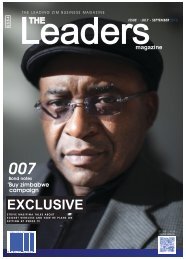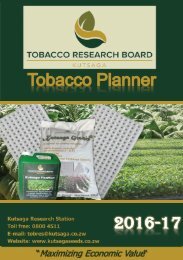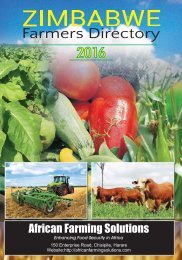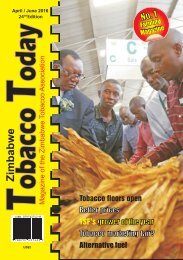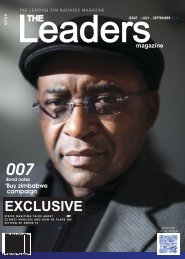livestock
You also want an ePaper? Increase the reach of your titles
YUMPU automatically turns print PDFs into web optimized ePapers that Google loves.
A Magazine for Livestock and Meat Advisory Council & its allied associations<br />
Mashona Cattle Society marks 65 proud years<br />
continued from page ...9<br />
Twenty years on, this corroborates the Zimbabwe's Mashona breed has also The Indibreed Group Breeding<br />
results of Zimbabwe's most extensive attracted interest in the United States, Scheme, operated by the society for 10<br />
cattle breed comparison trial at w h e r e t h e e m p h a s i s h a s ye ar s, w as established to speed up<br />
Matopos Research Station in the traditionally been on breeding larger Mashona genetic selection and forms a<br />
1990s, where the Mashona was animals. Crossbreeding work in New nucleus herd; in a scheme also<br />
unrivalled on natural veld. During “the Mexico has shown that Mashona cross designed to feed improved stock back<br />
worst drought in living memory” in steers were the only animals to turn a into communal herds for genetic<br />
1992, it was evident that the Mashona profit on natural grassland with no improvement.<br />
were able not only to survive adverse supplements. In meat analysis tests, this<br />
conditions but to produce a calf again “true grass breed” scored a high Today, working in conjunction with<br />
the following year. flavour rating and showed good ZHB, Zimbabwe's Mashona cattle<br />
marbling.<br />
breeders continue to improve the breed<br />
“Kilogram for kilogram, Mashona<br />
for greater productivity and resilience<br />
cattle will give more kilos of calf, per In Zimbabwean cattle research and under climate change—one of the<br />
kilo of cow put to the bull,” notes Dr evaluation, the adoption of the greatest challenges to global<br />
Bruce. On the role that the Mashona Mashona as the baseline breed is a agriculture.<br />
can play in the dairy industry today, the proud achievement for the MCS, which<br />
MCS chairman says. “We can in 1968 initiated the first research work - From the Mashona Cattle Society.<br />
crossbreed for hybrid vigour, with sexed on indigenous cattle<br />
dairy semen to produce hardy, good in the country to<br />
milkers for communal farmers.” demonstrate that<br />
indigenous cattle<br />
The MCS has also devised a breeds can also be<br />
programme to help interested small- genetically improved<br />
scale farmers to become fully w i t h s e l e c t i v e<br />
registered pedigree breeders. In this breeding. In the<br />
open appendix system, new breeders 1960s and 70s the<br />
can register with the Zimbabwe Herd society campaigned<br />
Book (ZHB) and work with the MCS to to save the Mashona<br />
upgrade their foundation Mashona breed from genetic<br />
cows to fully registered stud animals dilution in a massive<br />
over three generations.<br />
A .I. programme<br />
intended to improve<br />
The value of Zimbabwe's Mashona all communal cattle<br />
breed is well recognised today. It is with exotic cattle<br />
understood that the Mashona's small genes, a misguided<br />
size is part of its survival mechanism, policy.<br />
evolved over thousands of years for<br />
productive efficiency under harsh To make best use of<br />
environmental conditions. These Zimbabwe's fine<br />
include heat tolerance, resistance to cattle heritage, new<br />
ticks, flies and parasite infestation, high Mashona genetics in<br />
fertility and reproductive efficiency, a the communal herd<br />
lower maintenance requirement as well must be identified to<br />
as foraging ability and strong teeth for broaden the gene<br />
optimum utilization of the veld and pool for breeding, a<br />
efficient conversion of grass into beef process begun by the<br />
or milk. MCS in the 1990s.<br />
Livestock Today April-June 2016 13



